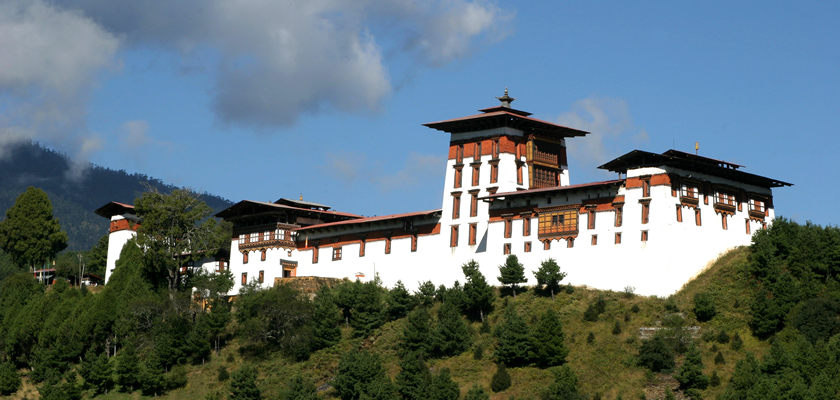" Take nothing but memories, leave nothing but foot prints "
- The Himalayan Kingdom of BHUTAN -What to see in Bumthang
Jambey Lhakhang: Tibetan King, Songtsen Gembo, believed to be the reincarnation of the Buddha of compassion, built this monastery in 7th century. It is one of the 108 monasteries built by him to subdue evil spirits in the Himalayan region
Kurje Lhakhang: Located above Jambey Lhakhang, the Kurje Lhakhang consists of three temples. The one on the right was built in 1652 on the rock face where Guru meditated in the 8th century. Second temple is built on the site of a cave containing a rock with the imprint of Guru’s body and is therefore considered the most holy. The present Royal Queen Mother recently built the third temples. These three temples are surrounded by 108 chorten wall, symbolic of each joint of the human body.
Tamshing Lhakhang: Located opposite Kurje Lhakhang on the other side of the river, this temple was founded in 1501 by Terton Pema Lingpa, the re-incarnation of Guru Padmasambhava. The monastery has very interesting religious paintings like 1,000 Buddhas and 21 Taras (female form of Buddhistava). The temple was restored at the end of the 19th century.
Jakar Dzong: Founded by great grandfather of Shabdrung, the Dzong was initially built as a monastery in 1549. It was upgraded after the Shabdrung had firmly established his power in 1646. The Dzong is now used as administrative center for Bumthang valley.
Membertsho: Located along the way to the Tang village over the feeder road under Bumthang valley, it takes thirty minutes drive to the Mebar Tsho from the Chamkhar town.
Mebar Tsho is considered one of the most sacred sites in the region as it relates to the renowned treasure reveler, Terton Pema Lingpa-incarnated disciple of Padmasambhava who discovered treasure from the lake somewhere around late 15th century.
It is believed that Terton Pema Lingpa had a vision about hidden treasures to be found at the foot of Tang Valley, which was indicated by Guru Rinpoche many centuries before. Since the people of tang and the local ruler was cynical about it, he held a butter lamp in his hand, he jumped into the lake, remained under water for a long time, and he re-emerged holding a chest and a scroll of paper in his hand and the butter lamp held in his hand still burning bright. Thereafter, the lake came to be known as Mebartsho (the burning Lake).
Today this small fresh water lake is a sacred pilgrimage place for Bhutanese with bright multicolored prayer flags surrounding the place and on auspicious days people go and offer butter lamps on the lake. Many tourist visit the site to observe spectacular beauty of the place and it is also an important site for historians.
Thangbi Goemba
A walk of about 30 minutes north of Kurje Lhakhang leads one to this monastery, situated in the middle of a wide fertile plateau overlooking the river. Founded in 1470 by Shamar Rinpoche of the Karma Kagyupa religious school, the building comprises two sanctuaries and a temple of terrifying deities. The sanctuary on the ground floor contains statues of the past, present and future Buddhas and three clay statues probably dating to the end of the 15th century. On the upper floor, the vestibule contains two remarkable paintings of Guru Rinpoche’s heaven, and the Buddha Amitabha’s heaven.
Ngang Lhakhang
This temple is a few hours’ walk from Thangbi Gompa, situated about 100m above the valley floor in the small region of Ngang Yule (“Swan Land”). The site was visited by Guru Rinpoche. The present temple was built in the 15th century by Lama Namkha Samdup, a contemporary of Pema Lingpa. A three day festival is held here each winter, with masked dances in honor of the founder of the temple.
Ura valley
From Jakar to Ura is 48 km., about one and a half hours’ drive. To reach here, the road climbs through amazingly open countryside, only occasionally running into forest. Sheep pastures line the road up to 20 km. behind the southern tip of the Tang valley. The road crosses Ura-la pass (3,600m), on the approach to which there is a magnificent view of Mt. Gangkar Puensum. Villages in Ura have clustered houses, which is quite unusual in Bhutan. Above Ura village (3,100m) there is a new temple is dedicated to Guru Rinpoche. Inaugurated in 1986, it contains a huge statue of the Guru and remarkable wall paintings of the cycle of his teachings. Within the last 25 years Ura has been transformed from a marginal community to a prosperous valley.
